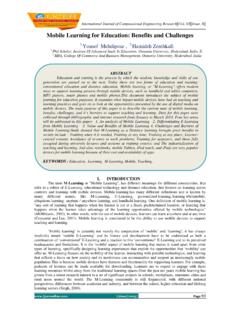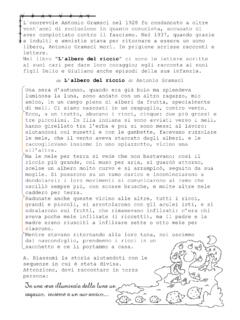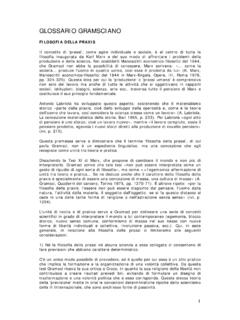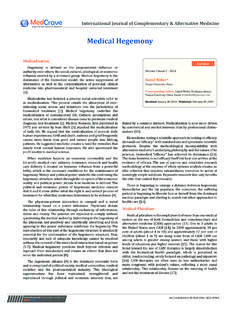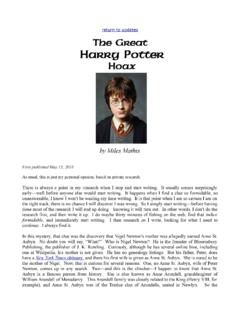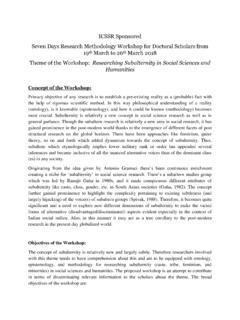Transcription of Subaltern Voice in Shakespeare: A Study in The …
1 ISSN (e): 2250 3005 || Vol, 04 || Issue, 5 || May 2014 || International Journal of Computational Engineering Research (IJCER) Open Access Journal Page 63 Subaltern Voice in Shakespeare: A Study in The Tempest Tribeni Mandal, ,Science College, Kokrajhar, Affiliated to Gauhati University I. INTRODUCTION The term Subaltern refers to any person or group of inferior rank and station, may be for race, class, gender, sexual orientation, ethnicity or religion. It is the social group who is socially, politically and geographically outside of the hegemonic power structure of the colony and of the colonial homeland. It is derived from the cultural hegemony work of Antonio Gramsci, which identified the social groups who are excluded from a society s established structures for political representation, the means by which people have a Voice in their society.
2 In Post-colonial theory, the term Sublaltern describes the lower classes and the social groups who are at the margins of a society. But Gayatri Spivak advised against a too broad application of the term. The subalterns are peoples who have been silenced in the administration of the colonial states they constitute. Gayatri Spivak in an essay titled, Can the Subaltern Speak? wrote: The Subaltern cannot speak. There is no virtue in global laundry lists with woman as a pious. Representation has not withered away. The female intellectual has a circumscribe task which she must not disown with a flourish. ( ) She put emphasis on the pitiable condition of women who are not only oppressed by patriarchy but also by colonialism. The most famous name among all Sublaltern Historians is unquestionably Ranajit Guha. The most powerful example of Subaltern historical scholarship is his Elementary Aspects of Peasants Insurgency in Colonial India where he offers a fascinating account of the peasants insurgent consciousness, rumours, mystic visions, religiosity and bonds of community.
3 Shakespeare s plays often resurface with female characters which tell us not only his view of women but also their status in Shakespeare s time. These characters are of a bawdy woman like the Nurse in Romeo and Juliet, Margaret in Much Ado About Nothing or Audrey in As You Like It; the tragic innocent woman like Juliet in Romeo and Juliet, Lavinia in Titus Andronicus, or Ophelia in Hamlet; the scheming Femme Fatal like ABSTRACT: The term Subaltern is an allusion to the work of Antonio Gramsci (1891-1973), an Italian Marxist. It means a person or group of persons belonging to an inferior rank and station, may be for race, class, gender, sexual orientation, ethnicity or religion. In 1980s, there arose a group named Subaltern Studies Group (SSG). It was influenced by the scholarship of Eric Stokes and Ranajit Guha. They tried to formulate a new narrative of the history of India and South Asia. They focused on the subalterns or the non-elites as agents of social and political change.
4 This paper in its present form is the result of a Study on Shakespeare and the Subaltern where an analysis will be made on some of the works of Shakespeare and his treatment of the marginalized section of the society in them with a special reference to the Subaltern characters in The paper uses Gramsci s conception of hegemony where it is a condition in which the supremacy of a social group is achieved not only by physical force but also throughconsensual submission of the very people who were dominated (Litowitz 2000, ).According to Gramsci there are two levels of hegemony. These two levels correspond on one hand to the function of hegemony which the dominant group exercises throughout society and on the other hand to that of direct domination or command exercised through the state and the juridical government (Gramsci 1971, ). in The Tempest one can find a reflection of England s colonial expansion.
5 The play has been undoubtedly interpreted as a play about colonialism. It is simply for Prospero s coming to Sycorax s island, subduing her, ruling and imposing his own culture on the natives. Prospero tries to civilize and educate Caliban but with the accompaniment of politics of dominization over the colonized. KEY WORDS : Subaltern , Antonio Gramsci, Italian Marxist, Subaltern Studies Group (SSG), Eric Stokes, Ranajit Guha, Shakespeare, Marginalised. Subaltern Voice In Open Access Journal Page 64 lady Macbeth in Macbeth or King Lears daughters, Goneril and Regan in King Lear; the witty woman like Katherine in The Tamimg of The Shrew; the married woman who dresses as men like Rosalind in As You Like It and Viola in Twelfth Night; women falsely accused of Adultery like Desdemona in Othello and Hero in Much Ado About construction of female characters in Shakespeare s plays reflects the Elizabethan image of woman in general.
6 They have been bound to rules and conventions of the Patriarchal Elizabethan era. In his comedies the world of women is safe where she is happy and comes to full flowering. Shakespeare has created every shade of womanhood, from Miranda s simplicity and innocence to Cleopatra s eternal courtesan. His women are exteremely individualized even when they resemble the particular one. Coming to the tragic heroines, they are pathetic, helpless and are always eclipsed by the towering personality of the hero. Except Cleopatra, everyone from Ophelia to Desdemona and Cordelia are all helpless and pathetic. Shakespeare s women are very practical, lively and resourceful. They take the stage in the grip of their hand. One can find the simplicity in thought, frankness and eloquency in discourse in the characters of Rosalind, Portia and Viola. Shakespeare s heroines are uplifted by love and they are self-sacrificing, passionate, virtuous and chaste.
7 II. Objectives And Methodology The objective of the paper is to make an analysis of the Subaltern characters in Shakespeare with a special emphasis on the characters in The methodology used here is analytical and help of secondary sources of information has been taken like journals, articles, books etc. III. DISCUSSION Helen Zimmern, in the preface to the English translation of Louis Lewe s Study The Women of Shakespeare, argued in 1895 that of Shakespeare s dramatis personae, his women are perhaps the most attractive, and also, in a sense, his most original creations, so different are they, as a whole, from the ideals of the feminine type prevalent in the literature of his day. In Shakespeare s plays female characters play an important role for the dramatic run of events. Women in Elizabethan period were considered as the weaker sex and they represented virtues like obedience, silence, sexual chastity, piety, humility, constancy and patience.
8 Women in that period were the housewives and mothers. But within this deprived, tight and organized schedule, they have been represented in their most diverse ways by the Bard. In Shakespeare s time women had less freedom than their male counterparts. Women who were born high are presented in his plays as mere possessions only who would have been passed from father to the husbands. They are socially bound and restricted within a framework in such a way that they are unable to move or see the world around them without servants or maids. They are always under the strict guidance of their men. Women in Shakespeare s plays who are socially low are shown as sexually aware. Women are never totally free in the plays of Shakespeare for they are always in the possession of either the husbands or the fathers. Some are even owned by their employers. Shakespeare suspected women in power and are thus portrayed having a questionable moral.
9 Here one can take the case of Gertrude and Lady Macbeth where the former is shown marrying her husband and the latter is shown as a lady who compels her husband into murder and both of them meet their fate as a penalty for their own act. No doubt, Shakespeare gave enough space to his female protagonists still his plays do not address the role of women royalty. In both Hamlet and Macbeth, Shakespeare implicitly states the danger of women being in power. The real political issues of the Elizabethan era were dramatized through the portrayal of the character of Hamlet s mother, Gertrude and also through Lady Macbeth s passionate and uncontrolled ambition for power. Gender anxieties are reflected and the chaos created as such from this kind of anxiety is revealed. Female leadership is thus questioned by Shakespeare. Desire for stability clearly demonstrates itself in both Macbeth and Hamlet. In Macbeth, a suggestion of Kingship and power leads Lady Macbeth to convince and instigate her husband to commit a crime by murdering the King and crowning himself.
10 In Hamlet, Gertrude the mother of Hamlet marries Claudius, the uncle and the murderer of his father. Their union throws the power of the crown in dispute between Hamlet, the King s son and Claudius, now husband of the Queen. In both these plays, women and their actions lead to instability in the state and a break of peace occurs as a result. Each drama reflects social anxieties from female rule. Lady Macbeth s disruption emerges from her ambition and this ambition is made high by her gender. After reading Macbeth s revelation of the witches predictions, she thinks that only her insistence will lead Macbeth to acquire the position of a King. Lady Macbeth is exemplified as a negative anode of female ambition and power. In Lady Macbeth the feminine desires for power were seen unnatural: Come you spirits That tend on mortal thoughts, unsex me here And fill me, from the crown to the toe, top-full of direst cruelty!




